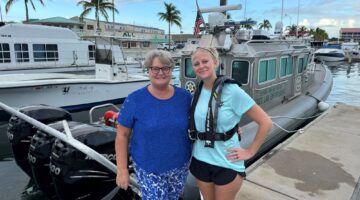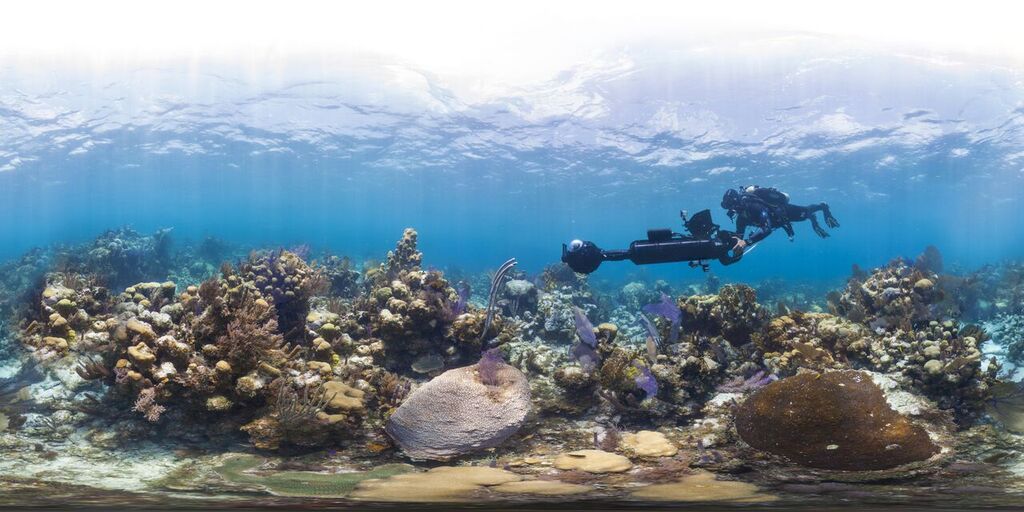Scientists race to save Florida Reef from killer disease
By ADRIANA BRASILEIRO Miami Herald
MIAMI (AP) — On a sunny afternoon in Dania Beach, a dozen scientists unloaded crates full of corals from a dive boat and onto a pickup truck. They gently removed each piece from large tanks on the deck and placed them inside smaller containers, which were slowly taken onshore.
The operation is part of what scientists describe as a “Noah’s Ark” mission to save corals from extinction as a mysterious disease ravages mile after mile of the Florida Reef Tract. Since first being spotted in 2014, the disease has killed colonies already weakened by impacts from climate change, including frequent rounds of bleaching and rising ocean acidification.
During one trip earlier this month, researchers spent six days diving in the Lower Keys to collect corals that haven’t yet been touched by the epidemic of what is called stony coral tissue loss disease. Their mission, as the “Ark” reference suggests, is to preserve healthy examples of species that can be cultivated in labs, then later transplanted back to the barrier reef that parallels much of the Southeast Florida coastline.

Interuniversity Institute for Marine Sciences, IUI, shows corals at the institute’s coral farm in the Red Sea city of Eilat, southern Israel. As the outlook for coral reefs across our warming planet grows grimmer than ever, scientists have discovered a rare glimmer of hope: the corals of the northern Red Sea may survive, and even thrive, into the next century. The coral reefs at the northernmost tip of the Red Sea are exhibiting remarkable resistance to the rising water temperatures and acidification facing the region, according recent research conducted by IUI. (Interuniversity Institute for Marine Sciences/Dror Komet via AP)
“It’s a Herculean effort, but we need to do everything we can to help corals survive,” said Richard Dodge, dean of Nova Southeastern University’s Halmos College of Natural Sciences and Oceanography, as he watched university staff and volunteers place the 341 corals in holding tanks on the university dock across from Port Everglades.
NSU is one of seven research facilities that will act as temporary hosts for specimens collected for what is formally known as the Coral Rescue Collection Plan, part of an ambitious program led by the National Oceanographic and Atmospheric Administration. NSU researchers will collect data on the species, then send them to other universities and zoos across the country, where they will be used to grow new colonies — seed stock for potential restoration efforts in the future.
The challenges to the survival of Florida’s reefs are immense. More than half of the corals have disappeared over the past 250 years, hammered by development, pollution, boat anchors and groundings, frequent bleaching events and, recently, climate change. Warmer sea temperatures, sea level rise and changes in storm intensity are all concerns, but the out-of-control stony coral tissue loss outbreak in recent years brought new urgency to coral rescue efforts.
If Florida’s reefs disappear, it would wipe out economically valuable destinations that draw boaters and divers but that are even more important to the biological health of South Florida’s offshore waters. Coral reefs create habitats that provide shelter and food for hundreds of species, from fishes to lobster. The reef also serves as a buffer that protects coastal areas against hurricanes and storm surge.
Growing corals in a lab or even in offshore gardens isn’t new. But recovery programs like the one NSU has joined are getting more sophisticated as threats intensify. Most previous work has focused on the large branching corals that have nearly vanished from South Florida waters — the critically endangered staghorn and elkhorn corals.
This program expands restoration efforts, targeting species that are more susceptible to the disease and die faster or those that have higher coral-building capacity, which would speed restoration.
During the journey from the southern Keys to NSU’s coral nursery, everything was meticulously controlled to guarantee the corals remained healthy. They traveled in insulated bins that were shaded by black tarp. The water in the tanks was constantly monitored to prevent even a trace of disease from tainting the specimens. Only the strong will survive and, hopefully, guarantee a pool of genetic wealth to regrow more colonies in the future.
Though some corals may look like rock formations, they are very fragile and require a lot of love and care. The variety of corals in NSU’s precious collection from the Keys was surprising: Some resembled small flower arrangements while others looked like images of the emerald-green Irish countryside seen from above.
Removing them from the ocean is a challenging balance of strength and delicacy: Diver scientists use a chisel and hammer to chip at spaces between the coral and the structure where it grows until it pops out.
At the NSU nursery, marine biologists worked methodically to give the corals the best chance of survival, dipping each piece in a solution of antibiotics and vitamins, rinsing them off and whisking them away to designated tanks.
“In these first days bringing them from their homes in the ocean and moving them to our tanks, they may experience some stress, so we need to avoid that at all costs,” said Nick Turner, research assistant and a lab manager at NSU.
And it’s not easy to keep corals happy outside of the ocean. Light and water conditions need to be constantly monitored, with the right level of nutrients to guarantee their survival at NSU’s coral nursery. The area is covered with light beige cloth to simulate the dimmer sunlight that reaches corals in their natural habitat, about 20 feet below the surface.
Kyle Pisano, the university’s self-described coral nanny, said the hard work is worth it. His job is not only to make sure the corals survive the transition from NSU’s holding tanks to their next stops in the rescue project, but that they are healthy enough to reproduce.
“The whole point of this project and of our work here is to make sure we get the best possible specimens of different species, because they will provide new individuals to be transplanted,” Pisano said.
Scientists know they are racing against time against a disease they don’t know yet know much about. What’s causing it? No one can even say yet.
“We are trying to stop it, and at the same time we are working to make sure we can at least restore some of the colonies,” said Dodge.
___
Information from: The Miami Herald, http://www.herald.com










No Comment